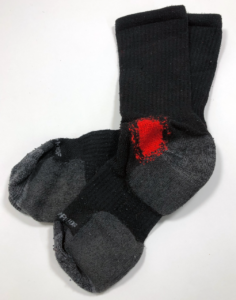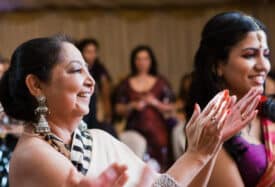An African Way to Die

Photograph: A Sunset in Africa by Tim Heywood
George Gumisiriza is a PhD student based at the Centre for Death and Society (CDAS) at the University of Bath. His ongoing research is titled Repatriationscapes: Afrocentric perspectives on death and body repatriation among the African diaspora.
George has spoken about the importance of home and place in relation to death and grief, particularly within African cultures.
For Dying Matters Awareness Week (2-6 May 2022), we asked him to share his thoughts on what it means to be in a good place to die.

Repatriation is the process of returning an asset, an item of symbolic value, or person – voluntarily or forcibly – to its owner or their place of origin or citizenship. As an African who has lived in the UK for 10 years, I draw on my own experience of grief after loss as part of my research.
In December 2013, my cousin Paul, aged 48, returned to Uganda to die after 20 years in the UK. Paul had AIDS after contracting HIV in the 1990s. He died in April 2014. Paul’s last words to me about his decision were: “This winter is going to be very cold in England. I’ve got you a pair of socks and a scarf to keep you warm. I’m going home to Uganda and will stay there until summer next year.” Paul often said that Africa was his homeland and London was his place of dwelling. Paul knew that his death was close. The pair of socks and scarf symbolize both our grief and consolation. Material objects of memory can be helpful in handling grief after loss.
Recently, long illnesses and stigmatized diseases such as HIV have prompted people to think about how and where we die. However, what does it mean being in a ‘good place’ to die? How do things hold together in the face of death, and grief after loss?
African rituals
Like my cousin Paul, my thoughts about being in a good place to die are connected to my African sense of belonging. When I think on my death bed, I envisage people visiting me. I imagine people crying loudly after my last breath and people gathered in the courtyard for the funeral. Huge log fire at my funeral wake, a condolence book, and a basket for collecting the money. Mourners make contributions in cash, in kind or both because in African death ways bereavement is shared. I imagine the men digging the grave in the banana grove, talking about recent community misdemeanour. Grave digging in most Ugandan cultures is an opportunity for self-reflection and correction. The senior family head chooses the spot for the grave. The other seniors sit around to supervise the process as the younger men dig the grave in turns. Local brew of alcohol and a meal are served at the site. I see the women cooking food – receiving baskets of cooked food from the neighbours – young adults serving all the mourners.
Finally, I hear the loud cries of women as men carry my corpse to the grave. I hear dried banana leaves as crowds struggle to find their way and space around the grave. As the coffin is lowered, I hear the competing sounds of mild argument – panic, and loud wailing of mourners. Believers may try to restrain people through singing of hymns, but women – widows and bereaved mothers – are often unstoppable. Men do cry loudly too, in some cases. For many Africans, like my cousin Paul, the place and space are important for such rituals and practices.
Like my cousin Paul, my thoughts about being in a good place to die are connected to my African sense of belonging. When I think on my death bed, I envisage people visiting me. I imagine people crying loudly after my last breath and people gathered in the courtyard for the funeral. Huge log fire at my funeral wake, a condolence book, and a basket for collecting the money. Mourners make contributions in cash, in kind or both because in African death ways bereavement is shared. I imagine the men digging the grave in the banana grove, talking about recent community misdemeanour.George Gumisiriza
My Masters research on death and body repatriation among Gambians in Wales (UK), revealed many similarities between their West African experience and mine, rooted in collective understanding of home as the land of birth. Gambians support their dying folks to return to the Gambia before death. However, this is not always possible, and sometimes corpses are repatriated after death. Gambian Muslims prefer to bury their dead in Muslim-only cemeteries where, as one interviewee told me, all the rituals are fulfilled. Other participants mentioned having prayers over the grave every morning and relatives visiting every day. This combines cultural and religious ways of grief and the meaning of being in a good place to die for the dying and the survivors.
Returning home
The idea of dying at home is popular among Africans as a physical place and space to die. ‘Home’ as a place combines the support from relations beyond the immediate family. Home is thought to provide the sense of comfort and security that people enjoy in good times. In moments of weakness, despair, and hopelessness due to terminal illness, home as a familiar place presupposes reassurance to control the situation. While not all people prefer dying at home, in Africa, returning an elderly person home from the hospital means two things: either the person has recovered, or the patient has demanded to return home to die. Whichever the case, home is considered a ‘convenient place’ to offer social support. Sometimes, spiritual leaders and medical professionals visit to offer their services. Migrants with such preference might find ‘home’ as a physical place to die challenging due to lack of social support available in their place of birth, where social connections with them have become thinner.

In African cultures, the space in a dying person’s home focuses on the person, the dying process, and the event of death. The dying individual occupies space that is well lit and accessible. Social and cultural norms oblige folks to visit the dying. Despite the absence of death in open conversation, people act quickly when death is imminent. Responding to the dying’s social needs is prioritised to avoid regrets. Some activities outside the physical space consider how death may affect their plans. Banyoro / Batooro people in Western Uganda say, “taraleho – tasibeho” referring to imminent death by “sunrise or sunset.” Low-tone dying pep-talks of prompts and reminders about visiting the dying individual are common.
Abating the crisis of death
My native Runyoro / Rutooro language draws similarities between a ‘good death’ and the grave: the saying, “Olifa kurungi ogisanga hamunwa gwekituuro,” means a ‘good death’ is determined at the ‘mouth’ of the grave. The saying refers to both the individual and collective meaning of ‘a convenient place’ to die. Death very often causes chaos among the survivors. Some Africans seek practical ways to minimise the disorganisation that often follows death occurrence. Repositioning the dying to somewhere perceived as a ‘convenient place’ to die is widespread among African diaspora, for example, moving from urban back to rural homes to die is common. The other way is repatriation of the corpse after death for funeral rites and rituals. The difficulty in body repatriation involves cross-border regulations and excessive costs.
In African cultures, the space in a dying person’s home focuses on the person, the dying process, and the event of death. The dying individual occupies space that is well lit and accessible. Social and cultural norms oblige folks to visit the dying. Despite the absence of death in open conversation, people act quickly when death is imminent. Responding to the dying’s social needs is prioritised to avoid regrets.George Gumisiriza
Repatriating a corpse is much more expensive than repatriating a living person. Yasmin Gunaratnam has fascinating stories about this, including a dying person snatched from their hospice bed by their family to put them on a flight home to die: the hospice had refused the request, as it considered the patient too ill to move. Another example in her book is a family who put a corpse in a wheelchair, and accompanied it on the plane, pretending the body to be living as they could not afford the cost of repatriation after death.
My cousin Paul was a professional dancer who loved pop-culture that embodies Afro-Western narratives, fashion, elegance, and creativity. Paul’s decision to return home was about his need to retain respect and dignity in the face of death. The Ugandan singer Philly Lutaaya’s song Alone and Frightened, which became “The Aids Anthem” in Uganda, describes the meaning of being in a ‘good place’ to die. The story starts with his personal grief and the need for resilience, emphasizing his longing to belong. In 1989, Philly returned to Uganda from Sweden and died in the care of his family.

Other cultures
Many cultures share some common thoughts about a good death. First, the visibility of the dying individual and the illness. Second, dying as a process, death as an event, and after death as rites or ceremonies. Third, the survivors and the practice within the place and space. In a recent case, the neuroscientist Dr. Nadia Chaudhri, a professor of Psychology at Concordia University in Montreal, Canada, died from ovarian cancer on October 5, 2021.
In the final weeks of her life, Nadia daily shared her story online via her Twitter account (@DrNadiaChaudri), from her palliative care ward. Towards the end, Nadia said, “I will feast in my new life and welcome everyone to my forest table” (@DrNadiaChaudhri, 13 September 2021).
Nadia’s story indicates how she took control of a difficult situation reaching out to the world. She cared about the grief of the survivors after her death through her trust in the place, the space and the people who cared for her. Nadia Chaudhri – a migrant to Canada from Pakistan, she had a good dying not in her Pakistani home, but with her family in Canada, and finally in a Canadian palliative care ward. That for her was a good place.
In African death ways, repositioning dying individuals protects them from being excluded from cultural funeral rites after death. Both my cousin Paul and the singer Philly reassured themselves of being incorporated among the dead on the ancestral grounds. Paul’s socks kept me connected to other grieving survivors at home after his death. The work of my friend and fellow doctoral candidate Katie Taylor in mending the hole in my socks demonstrates support across cultures, based on shared experiences of death, dying and grief.
Further reading
- Adinkrah, M., 2022. “We Will All Go, But What We All Seek Is Good Death”: Cultural Notions of Good Death and Related Mortuary Rituals Among the Akan of Ghana. OMEGA-Journal of Death and Dying
- Gunaratnam, Yasmin. Death and the Migrant: Bodies, Borders and Care. London: Bloomsbury Academic, 2013.

George Gumisiriza is pursuing a PhD in Social and Policy Sciences, funded by Economic and Social Research Council (ESRC) and the University of Bath. He is based at the Centre for Death and Society (CDAS). His PhD thesis is Repatriationscapes: death and body repatriation among African diaspora in the UK. His work focuses on Afrocentric perspectives on death.
George has a Master of Research in International Development (distinction), (University of Bath in 2021), a Master of Science in Social and Cultural Theory, (Merit) (University of Bristol, UK 2020) and Bachelor of Education (Honours) from Makerere University, Uganda.
George moved to the UK in 2011.
Email: [email protected]
Twitter: @GeorgeGumisiri4
There’s much more to death than we think; what if it isn’t just an ending, but an event we can plan for? Thinking beyond the four walls of hospices and hospitals, we have the chance to approach it with confidence and plan a good death. After Wards is a collection of insights and ideas from people who can help us all to re-imagine this essential part of life, and to live well until we die.


